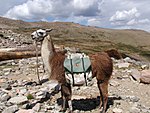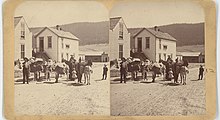
A pack animal, also known as a sumpter animal or beast of burden, is a working animal used to transport goods or materials by carrying them, usually on its back.
Domestic animals of many species are used in this way, among them alpacas, Bactrian camels, donkeys, dromedaries, gayal, goats, horses, llamas, mules, reindeer, water buffaloes and yaks.
Diversity
Traditional pack animals include ungulates such as camels, the domestic yak, reindeer, goats, water buffaloes, and llama, and domesticated members of the horse family including horses, donkeys, and mules. Occasionally, dogs can be used to carry small loads.
Pack animals by region
- Arctic - Reindeer and sled dogs
- Central Africa and Southern Africa - Oxen, mules, donkeys
- Eurasia - Donkeys, oxen, Horses, mules
- North America - Horses, mules, donkeys, goats
- North Africa and Middle East - Dromedaries, horses, donkeys, mules, oxen
- Oceania - Donkeys, horses, dromedaries, mules, oxen
- South America - Llamas, donkeys, mules
-
 A nomad's pack camel in Eyl, Somalia
A nomad's pack camel in Eyl, Somalia
-
 Pack reindeer with Sami driver from The land of the midnight sun, c. 1881
Pack reindeer with Sami driver from The land of the midnight sun, c. 1881
-
 1900 advertisement showing pack yaks in Tibet
1900 advertisement showing pack yaks in Tibet
-
 Pack llama, Rocky Mountain National Park, Colorado
Pack llama, Rocky Mountain National Park, Colorado
-
 Pack water buffalo, Sumbawa, Indonesia, early 20th century
Pack water buffalo, Sumbawa, Indonesia, early 20th century
-
 Pack donkeys, Devon, England, c. 1906
Pack donkeys, Devon, England, c. 1906
Uses



Hauling of goods in wagons with horses and oxen gradually displaced the use of packhorses, which had been important until the Middle Ages, by the sixteenth century.
Pack animals may be fitted with pack saddles and may also carry saddlebags. Alternatively, a pair of weighted materials (often placed symmetrically) are called panniers.
While traditional usage of pack animals by nomadic tribespeople is declining, a new market is growing in the tourist expeditions industry in regions such as the High Atlas mountains of Morocco, allowing visitors the comfort of backpacking with animals. The use of pack animals "is considered a valid means of viewing and experiencing" some National Parks in America, subject to guidelines and closed areas.
In the 21st century, special forces have received guidance on the use of horses, mules, llamas, camels, dogs, and elephants as pack animals.
Load carrying capacity
The maximum load for a camel is roughly 300 kg (660 lb).
Yaks are loaded differently according to region. In Sichuan, 75 kilograms (165 lb) is carried for 30 km (19 mi) in 6 hours. In Qinghai, at 4,100 m (13,500 ft) altitude, packs of up to 300 kilograms (660 lb) are routinely carried, while up to 390 kilograms (860 lb) is carried by the heaviest steers for short periods.
Llamas can carry roughly a quarter of their body weight, so an adult male of 200 kilograms (440 lb) can carry some 50 kilograms (110 lb).
Loads for equids are disputed. The US Army specifies a maximum of 20 percent of body weight for mules walking up to 32 km (20 mi) a day in mountains, giving a load of up to about 91 kilograms (200 lb). However an 1867 text mentioned a load of up to 360 kilograms (800 lb). In India, the prevention of cruelty rules (1965) limit mules to 200 kilograms (440 lb) and ponies to 70 kilograms (150 lb).
Reindeer can carry up to 40 kg (88 lb) for a prolonged period in mountains.
See also
References
- "The Best Invention Since The Wheel". No Tech Magazine. 4 January 2012.
- "Pack Goats". No Tech Magazine. 13 December 2011.
- ^ "Pack-animal welfare checks introduced for the expeditions industry". The Donkey Sanctuary. 26 February 2015. Retrieved 26 January 2016.
- Aston, T. H. (2 November 2006). Landlords, Peasants and Politics in Medieval England. Cambridge University Press. pp. 54–55. ISBN 978-0-521-03127-1.
- "Horse & Pack Animal Use". National Park Service. Retrieved 26 January 2016.
- "FM 3-05.213 (FM 31-27) Special Forces Use of Pack Animals" (PDF). Headquarters, Department of the Army. June 2004. Retrieved 26 January 2016.
- CSIRO (2006). Model Code of Practice for the Welfare of Animals The Camel (Camelus dromedarius) (2nd ed.). CSIRO Publishing. p. 8.
- "Draught performance". Food and Agriculture Organization. Retrieved 31 January 2016.
- Bonner, Laurie (26 June 2008). "How Much Weight Can Your Horse Safely Carry?". Equus Magazine. Retrieved 31 January 2016.
- Nickul, Karl (1997). The Lappish Nation. Psychology Press. p. 29. ISBN 978-0-7007-0922-9.
External links
- Llama Backpacking Documentary produced by Oregon Public Broadcasting
| Mammals in culture | ||
|---|---|---|
| Topics |  | |
| Types | ||
| Working animals | ||
|---|---|---|
| Dog |  | |
| Horse | ||
| Other species | ||
| Related topics | ||